#remote admin tool hardware based
Explore tagged Tumblr posts
Text
USB RAT (Remote Administrator Tool )
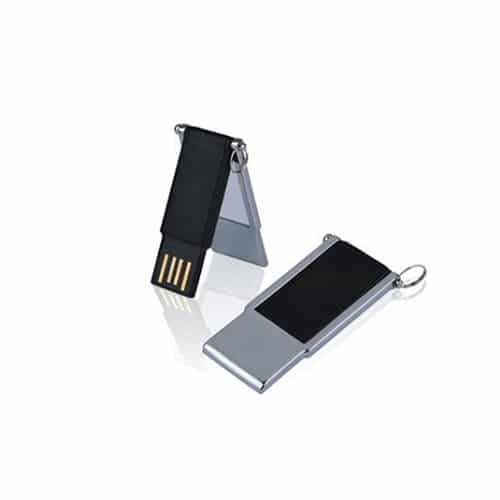
This Is Vary Advance USb RAT it can hack any High Secured servers and pc within second.
Its 100% Fud (Fully Undetactable by all Antiviruses )
its Silent Stealth .
it will run as Anonymous.
Its Untraceable.
Fully Strong Encrypted with 5 Security Layers.
Email Keyloggers.
What You can do with USB RAT.
just Put USB RAT into Any Highly Protected and multilayered SERVER Or PC Usb port as normal Pendrive.
After connect it will take just 5 to 8 seconds to start Remote connections.
100% FUD , Stealth and Multi Encrypted So Impossible to Detect and TRACK.
Fully Control Any Servers and Computers.
Send All Captured Text and Virtual Keyboard Clicks every 10 minutes .
you can use Victim Servers or Computers as Administrator.
Full Control .
Water proof .
PACKAGE CONTENT.
USB RAT PENDRIVE.
GUI BASED DashBoard for Administrator.
SERVER BASED CONTROL SYSTEM 24/7 Live.
5x time Dedicated SERVER For Online Control Your USB RAT for 3 Years.
Ultra HD VIDEO Traning.
24/7 Email Support.
Team Viewer Support.
1 year Hack-exploits Member with T-shirt .
0 notes
Text
Best Singapore Employee Mobile App | 1 SGD Time
In today’s fast-paced business environment, companies in Singapore need a reliable and cost-effective solution for employee attendance tracking. The 1 SGD Mobile Time Attendance app offers an innovative and budget-friendly way to manage workforce attendance using just a smartphone.

Why Choose a Mobile Time Attendance App?
Traditional time clock systems are often expensive, require hardware installation, and lack flexibility. A mobile time attendance app eliminates these challenges by allowing employees to clock in and out using their smartphones—anytime, anywhere.
For just 1 SGD per employee per month, businesses in Singapore can enjoy seamless attendance tracking, GPS location verification, and real-time reporting. This solution is perfect for SMEs, startups, and even large enterprises looking for a scalable and efficient workforce management tool.
Key Features of the Employee Mobile Time Attendance App
GPS-Based Attendance Tracking – Employees can clock in/out with location verification to prevent time theft.
Real-Time Reporting – Managers can monitor attendance data instantly via a web dashboard.
Shift Scheduling – Assign shifts and track employee work hours effortlessly.
Leave Management – Employees can apply for leave, and managers can approve requests within the app.
Multi-Platform Access – Works on both Android and iOS devices for maximum convenience.
Cloud-Based Storage – All attendance records are securely stored and easily accessible.
Cost-Effective – At just 1 SGD per employee per month, it’s the most affordable solution in Singapore.
Who Can Benefit from This App?
Small & Medium Enterprises (SMEs) – No need for expensive biometric systems.
Remote & Field Workers – Track attendance even when employees are off-site.
Retail & F&B Businesses – Manage shift workers efficiently.
Construction & Logistics Companies – Monitor on-site employees with GPS verification.
How It Works
Sign Up – Register your company and add employees.
Download the App – Employees install the app on their smartphones.
Clock In/Out – Employees mark attendance with GPS verification.
Monitor & Manage – Supervisors access real-time reports via the admin dashboard.
For more details Visit us: https://mobileattendance.com.sg/employee-mobile-app/ Phone: +60–7 2133446 Whatsapp: +60 10–7155447 Email: [email protected]
1 note
·
View note
Text
Wagner Engineer: Building the Future Through Precision Engineering

In today’s fast-paced technological landscape, the need for agile, innovative, and expert engineering partners has never been greater. Whether you're a startup with a bold product idea or an established company needing to modernize complex systems, having the right engineering team can make or break your success. One name that has steadily built a reputation for delivering top-tier engineering solutions is Wagner Engineer.
Based in Chicago, Wagner Engineer offers a unique combination of technical depth, design intelligence, and forward-thinking development strategies. With a focus on electrical engineering, firmware, software, and cloud infrastructure, the firm is redefining how small to mid-sized businesses approach high-tech problem-solving.
A Founder with Vision
Wagner Engineer is the brainchild of Dylan Wagner, a University of Illinois alumnus with a background in electrical engineering and a career rooted in high-impact projects. From his early work on sensor-driven technologies to his leadership roles in engineering-intensive industries, Dylan brings both vision and hands-on experience. His approach combines rigorous engineering standards with a passion for innovation and ethical business.
Dylan’s philosophy is simple yet powerful: build well, build right, and do it with integrity. This belief is embedded in Wagner Engineer’s process and culture, and it has helped earn the firm the trust of clients across multiple sectors.
What Wagner Engineer Does Best
Wagner Engineer is not your average engineering consultancy. The company provides a full-stack approach to product and system development, allowing clients to seamlessly integrate various technologies under a single strategy.
1. Electrical and PCB Design
From concept to production-ready boards, Wagner Engineer designs printed circuit boards (PCBs) that are efficient, reliable, and scalable. They consider not just the electrical performance, but also manufacturability, serviceability, and aesthetics—ensuring the board is practical for real-world applications.
Their design services are ideal for companies developing IoT devices, consumer electronics, automation equipment, and more. Whether starting from a napkin sketch or refining a legacy design, Wagner Engineer delivers excellence.
2. Embedded Firmware Development
A great product is only as good as the code running beneath its surface. Wagner Engineer develops embedded firmware that allows electronic systems to operate intuitively and efficiently. Their team is well-versed in programming microcontrollers, managing low-level device communication, and building resilient embedded systems.
From wearables to industrial sensors, their firmware solutions focus on reliability, speed, and long-term performance—core pillars of successful hardware products.
3. Custom Software Development
In addition to hardware and embedded systems, Wagner Engineer builds powerful software tools that bring hardware to life. Whether it’s a user-facing application, an admin dashboard, or a full-featured web platform, the company designs software with clean architecture, responsive interfaces, and robust back-end logic.
Their software development services are tailored for companies seeking intuitive interfaces, real-time analytics, or secure system management tools—all designed with user experience and long-term support in mind.
4. Cloud Infrastructure and Systems Integration
Cloud technologies are no longer optional—they’re essential. Wagner Engineer helps businesses create scalable cloud infrastructure that integrates smoothly with physical devices and software systems. Whether your goal is real-time monitoring, remote device management, or secure data storage, Wagner Engineer has the expertise to deliver.
By designing robust infrastructure and APIs, they enable seamless communication between devices, apps, and servers, empowering businesses to automate, optimize, and scale.
Wagner Engineer’s Advantage
Several attributes distinguish Wagner Engineer in a competitive industry:
Cross-Disciplinary Expertise: Their in-house capabilities span electrical engineering, software, firmware, and cloud—eliminating the silos common in product development.
Client-Centered Design: Every project begins with a deep understanding of the client’s needs, target users, and long-term vision. They don’t just build; they co-create.
Attention to Detail: From wire traces to user workflows, Wagner Engineer prioritizes precision. Their team adheres to best practices at every level.
Agile and Scalable: Whether you’re launching a prototype or rolling out a global product line, Wagner Engineer offers the flexibility to scale up or pivot quickly.
Commitment to Quality: Every deliverable undergoes rigorous testing and quality assurance, ensuring reliability and maintainability.
Serving a Wide Range of Industries
Wagner Engineer has partnered with clients across a variety of sectors, including:
Medical Technology: Where compliance, safety, and precision are paramount
Smart Home and IoT: Devices that connect, communicate, and streamline lives
Industrial Automation: Systems that power manufacturing and logistics
Consumer Electronics: User-focused design that delivers functionality and appeal
Green Tech and Renewable Energy: Supporting the future of sustainable solutions
Their diverse portfolio demonstrates adaptability and deep knowledge across use cases.
Partner Testimonials
Clients frequently cite Wagner Engineer’s responsiveness, technical mastery, and ability to “just get it done.” Many describe the team as an extension of their own, not just a service provider. Their ability to simplify the complex and deliver polished, working solutions—on time and within scope—has earned them repeat business and strong referrals.
How to Connect with Wagner Engineer
If you're ready to transform your ideas into working systems, Wagner Engineer is ready to partner with you. Whether you need help building your first prototype or managing the technical side of a large-scale deployment, they have the tools and talent to help.
📍 Location: 2540 W Grand Ave, Suite 2 PMB 917286, Chicago, IL 📞 Phone: +1 312-288-8764
Wagner Engineer is more than an engineering firm—it’s a strategic partner that blends technical expertise with real-world insight. With services spanning hardware to cloud, they offer a comprehensive toolkit for companies looking to innovate quickly and effectively. Backed by strong leadership and a commitment to doing things the right way, Wagner Engineer is helping shape the next generation of smart, connected technologies.
0 notes
Text
youtube
Summary
🛡️ Ethical Hackers Simulate a Real-World Attack A red team of ethical hackers performs a full-scale simulated attack on a power substation, testing physical, network, and human vulnerabilities—legally and with company permission.
🧠 Social Engineering as a Primary Vector The team uses social engineering to enter buildings. By posing as technicians and leveraging human psychology, they manipulate staff into granting access. Confidence, research, and believable personas were crucial.
🏢 Physical Security Bypassed with Simple Tools Gaps in fencing, unlocked doors, and “shove-it” or under-door tools were exploited. One team simply walked in from the employee lot, while another infiltrated via the wooded area behind the facility.
🖥��� Hardware Deployed for Persistent Network Access Once inside, the hackers installed malicious devices disguised as normal hardware to maintain remote access to the network. These allowed long-term entry and software execution.
🧰 Cloning Badges and USB Attacks The hackers used cloned employee badges and rigged USB drives that automatically executed scripts once plugged in. These granted access to microphones, webcams, screen captures, and remote control.
🎯 Domain Admin Access Achieved In one instance, the team escalated privileges to gain domain admin access, representing total control over the target’s digital infrastructure—just from a single visit.
🌐 Reconnaissance and Real-Time Adaptation The hackers conducted detailed recon: identifying security cameras, sensor placements, neighboring residences, and camera blind spots. Real-time decision-making played a vital role.
🔒 Lessons in Physical Cybersecurity Even high-tech systems can be bypassed with low-tech ingenuity. One method involved tossing a person over a fence and using shields to block motion/infrared sensors. Another involved tricking camera angles to avoid detection.
🔊 Listening and Surveillance Capabilities With installed software, they remotely activated microphones and webcams, making internal espionage a reality—highlighting the hybrid nature of physical and cyber intrusion.
🧠 Red Teaming Sparks Better Defenses The video concludes with reflections on the industry’s progress and the need for continued improvement. While companies are getting better at patching vulnerabilities, human error and physical access remain significant gaps.
Insights Based on Numbers
3 iPads and 1 laptop found within minutes: Demonstrates physical asset exposure risk during breaches.
One visit = Domain Admin: Highlights how quickly a security failure can escalate from physical entry to full network compromise.
280° camera angle bypassed: Strategic understanding of sensor and camera mechanics is a major OSINT takeaway.
$0 tools like “shove-it” and badge cloners proved devastatingly effective.
0 notes
Text
Revolutionizing Commercial Safety with Smart Security Systems
In today's hyper-connected, fast-paced commercial landscape, the stakes for safety and security have never been higher. Whether it’s protecting data, property, or personnel, businesses are under increasing pressure to adopt more agile and intelligent security solutions. The traditional lock-and-key model simply doesn’t cut it anymore. What’s emerging as the new standard? Smart security systems - technologies that integrate access control, surveillance, and real-time analytics into a seamless, user-friendly infrastructure.
Enterprises across India and around the globe are transitioning from outdated models to cloud-based, mobile-enabled, and biometric-powered platforms. These systems don’t just safeguard buildings - they also enhance efficiency, improve compliance, and boost overall organizational agility. Forward-thinking providers like Spintly are leading the way with solutions tailored to the dynamic needs of modern commercial spaces.
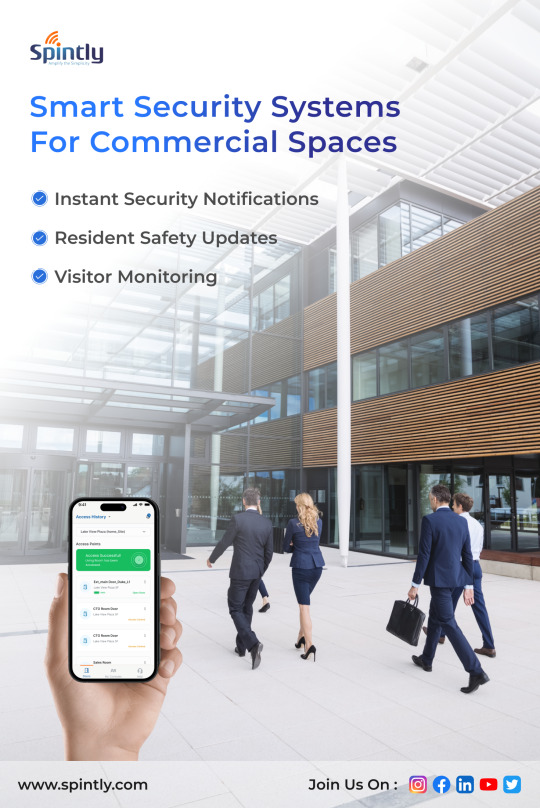
Why Traditional Security Falls Short
Conventional security systems—keycards, CCTV cameras, manual check-ins—were once sufficient. But in 2025, the challenges are different:
A rise in hybrid and remote work models
Increased demand for contactless interactions
The need for real-time monitoring
More complex compliance regulations
Multi-location facility management
Traditional systems often lack scalability and integration. They create silos of data, require expensive on-site infrastructure, and demand constant manual oversight. Simply put, they’re no longer compatible with the needs of today’s businesses.
What Makes a Security System “Smart”?
A smart security system is more than just tech - it's an ecosystem. It brings together access control, biometric authentication, cloud infrastructure, and AI-powered insights. Here's what sets these systems apart:
Cloud-Based Control Security teams can manage access from any location, update credentials remotely, and store data securely in the cloud.
Mobile-Enabled Access Employees and visitors can use smartphones to enter buildings, reducing the need for physical badges or touch-based systems.
Biometric Verification Facial recognition and fingerprint scanning enhance authentication while reducing fraud and “buddy punching.”
Real-Time Monitoring and Alerts Administrators receive instant notifications of suspicious activity, enabling proactive risk management.
Seamless Integrations These systems can work alongside visitor management, attendance tracking, and surveillance tools, creating a unified security infrastructure.
Advantages for Commercial Spaces
1. Scalability Across Locations
Businesses with multiple offices, factories, or warehouses need centralized control. Smart security systems allow for unified dashboards, enabling managers to oversee operations from a single interface. Whether it’s a tech campus in Bengaluru or a retail outlet in Mumbai, all locations can be monitored in real-time.
2. Enhanced Visitor Management
Gone are the days of logbooks and printed badges. Integrated visitor management systems streamline check-in processes using mobile pre-registration, biometric scans, and real-time identity verification. This not only increases security but also improves the visitor experience.
3. Operational Efficiency
Manual oversight and complex hardware requirements drain IT and admin resources. Smart systems automate these tasks - granting access permissions, maintaining logs, and even generating compliance reports - freeing teams to focus on strategic initiatives.
4. Cost-Effectiveness
While traditional systems come with high installation and maintenance costs, cloud-based platforms reduce hardware dependence. They’re subscription-based, scalable, and easy to update - resulting in a more predictable, budget-friendly model.
Use Case: Co-Working Spaces
Co-working spaces have exploded in popularity, but their shared nature introduces complex security challenges. With multiple tenants, rotating visitors, and sensitive data at stake, standard access control falls short.
Smart security systems resolve this by:
Allowing digital check-ins for guests
Issuing time-bound mobile credentials
Monitoring common areas via IoT-enabled surveillance
Offering customized access to different areas (meeting rooms, lockers, etc.)
Solutions from companies like Spintly enable co-working operators to maintain high levels of security while delivering a smooth and professional experience for tenants and guests alike.
Use Case: Corporate Campuses
Large corporate campuses often span multiple buildings and thousands of employees. Managing access manually is inefficient and risky. Smart systems offer:
Centralized access permissions for HR teams
Integration with biometric attendance systems
Real-time data analytics on occupancy and movement
Emergency lockdown features accessible remotely
These features don’t just secure the premises - they contribute to smarter building management and employee accountability.
Data Security and Compliance
With increasing scrutiny over data protection, businesses must ensure that their security systems comply with laws like the GDPR and India’s DPDP Act. Smart solutions offer:
End-to-end encryption of access logs
Role-based access control to sensitive data
Automated data retention policies
Secure cloud hosting with multi-factor authentication
By aligning physical security with digital data compliance, companies avoid penalties while building trust with stakeholders.
Why Spintly Stands Out
Among the growing list of security technology providers, Spintly has carved a niche by focusing on simplicity, scalability, and seamless integration. Their platform offers:
Mobile-based access using BLE and Wi-Fi
Biometric-enabled entry points
Cloud-native architecture
Real-time dashboards and alerts
Compatibility with third-party systems
Designed for modern workplaces, Spintly’s solutions are ideal for co-working spaces, educational institutions, enterprise campuses, and smart buildings. With an intuitive interface and low infrastructure requirements, businesses can implement powerful security without the typical complexities.
Preparing for the Future
Security isn’t static. As threats evolve, so must the defenses. Smart systems are future-proof by design. They receive OTA (over-the-air) updates, learn from user behavior using AI, and integrate new authentication methods as they emerge.
Investing in these technologies isn’t just about security - it’s about creating smarter, safer, and more adaptable environments.
Conclusion
Smart businesses can’t afford to treat security as an afterthought. As the lines between physical and digital workplaces blur, investing in intelligent, integrated security systems is essential. Whether you're safeguarding employees, protecting assets, or managing compliance, smart security platforms provide the devices to stay ahead of risks.
For organizations looking to modernize without complexity, platforms like Spintly offer a compelling way forward. With a combination of mobile-first design, cloud-based control, and user-friendly features, Spintly is helping redefine what security means in 2025 and beyond.
#securitysolutions#security systems#visitor management system#mobile access#accesscontrol#access control solutions#spintly#biometrics#smartacess#smartbuilding
0 notes
Text
Digital Signage Software for Smart TV: A Complete Guide to TV Content Management Systems

In today’s fast-paced digital environment, businesses and organizations are constantly looking for innovative ways to capture attention, deliver messages, and enhance customer engagement. One of the most effective tools for this is digital signage software for Smart TV. Whether you’re running a retail store, hotel, corporate office, or educational institution, a robust TV content management system can revolutionize how you display and manage content.
In this blog, we’ll explore how digital signage software works with Smart TVs, the benefits of using a TV content management system, and what to look for when choosing a solution. We’ll also include a helpful FAQ section to address common questions.
What is Digital Signage Software for Smart TV?
Digital signage software for Smart TV allows users to remotely manage and display multimedia content, such as videos, images, news tickers, or social media feeds, on Smart TVs. These systems are especially valuable in commercial environments, where centralized content control and real-time updates are essential.
Unlike traditional setups that require external media players or computers, many modern Smart TVs come with built-in support for digital signage apps. This makes the setup more streamlined and cost-effective.
Benefits of Using Digital Signage Software on Smart TVs
1. Cost Efficiency
Smart TVs eliminate the need for external hardware. A single device handles both content playback and display, reducing installation and maintenance costs.
2. Centralized TV Content Management System
With a powerful TV content management system, you can control what plays across multiple screens from a single dashboard. This is especially useful for businesses with multiple locations or departments.
3. Cloud-Based Access
Most modern digital signage solutions are cloud-based, allowing users to upload, schedule, and modify content from anywhere with internet access.
4. Scheduling and Automation
You can schedule different content for different times of the day or days of the week. For example, a restaurant might display breakfast specials in the morning and dinner promotions in the evening.
5. Real-Time Updates
Instantly push updates or emergency notifications to one or all screens. This is crucial for environments like schools, hospitals, or transportation hubs.
6. Content Variety
Display a wide range of media: promotional videos, slideshows, live data feeds (e.g., weather or social media), interactive content, or even QR codes for mobile engagement.
Key Features to Look for in a TV Content Management System
When selecting a digital signage solution for Smart TVs, consider the following features:
a. Compatibility
Ensure the software is compatible with the brand and operating system of your Smart TV (e.g., Tizen for Samsung, webOS for LG, Android TV, etc.).
b. User-Friendly Interface
Look for a drag-and-drop interface or template-based system that makes it easy to design and schedule content, even for non-technical users.
c. Multi-Screen Support
The ability to manage multiple screens from a single admin panel is essential for businesses with many displays.
d. Security
Choose a system that supports user access controls, data encryption, and secure cloud storage.
e. Analytics and Reporting
Advanced signage systems offer performance analytics, such as how often content is played or viewed, helping you measure effectiveness.
Use Cases: Where TV Digital Signage Software Shines
– Retail Stores
Promote sales, highlight featured products, and showcase customer reviews right at the point of purchase.
– Hospitality
Display welcome messages, event schedules, and promotional offers in hotel lobbies, conference rooms, or dining areas.
– Corporate Offices
Use digital signage for internal communications, performance dashboards, or training content in break rooms and common areas.
– Healthcare
Inform and educate patients in waiting areas with videos, health tips, and appointment reminders.
– Education
Post class schedules, campus events, safety alerts, or motivational content across school or university campuses.
How to Set Up Digital Signage on a Smart TV
Setting up digital signage software for Smart TV is simpler than you might expect:
Choose Your Software – Select a digital signage platform that supports your Smart TV brand.
Install the App – Download the signage app directly from the TV’s app store.
Register the Device – Link the TV to your content management system via a pairing code or QR scan.
Upload Content – Use the CMS dashboard to upload media files or create custom templates.
Schedule and Publish – Set content playback schedules and push them to your Smart TV remotely.
Popular Digital Signage Platforms for Smart TVs
Here are some widely used digital signage solutions that support Smart TVs:
Yodeck – Works with Android TVs and offers drag-and-drop simplicity.
ScreenCloud – Ideal for LG and Samsung TVs, cloud-based and scalable.
Novisign – Offers extensive template options and real-time content syncing.
XOGO – Supports various Smart TVs and provides a free tier for small users.
FAQs About Digital Signage Software and TV Content Management Systems
Q1: Can I use any Smart TV for digital signage?
A: Not all Smart TVs support professional-grade signage software. It’s best to use commercial-grade Smart TVs that offer features like auto power-on, screen timers, and remote management. LG (webOS), Samsung (Tizen), and Android-based TVs are the most compatible.
Q2: Do I need an internet connection to run digital signage on a Smart TV?
A: Yes, most cloud-based TV content management systems require an internet connection to sync content and manage screens remotely. However, some systems allow local caching, so content can continue to play even if the connection drops.
Q3: Is it safe to use Smart TVs for business signage?
A: With a secure digital signage solution, Smart TVs are safe to use for business applications. Look for platforms that offer SSL encryption, role-based user access, and remote device monitoring.
Q4: Can I display live data or real-time feeds?
A: Absolutely. Many digital signage solutions support integrations with live weather, news, social media feeds, and internal APIs to display real-time information.
Q5: What is the cost of a digital signage solution for Smart TVs?
A: Pricing varies based on the number of screens, features, and whether it’s a cloud-based or on-premise solution. Entry-level services might start as low as $10–$20 per screen per month, while enterprise solutions can run higher.
Q6: What happens if my Smart TV turns off or restarts?
A: Most digital signage apps will auto-launch on boot and reconnect to the content server. Ensure your Smart TV has kiosk or auto-start mode enabled for uninterrupted playback.
Q7: Can I manage multiple locations from one system?
A: Yes. A good TV content management system allows centralized control over displays in multiple geographic locations through a single admin dashboard.
Final Thoughts
Using digital signage software for Smart TV is a smart and efficient way to modernize your communication strategy. With an intuitive TV content management system, businesses can easily create, schedule, and distribute engaging content without needing expensive hardware or complex IT support.
As Smart TVs become more advanced and affordable, they are rapidly becoming the go-to choice for digital signage in every industry, from retail to healthcare to education.
Ready to elevate your visual communication strategy? Choose a reliable digital signage platform tailored for your Smart TV ecosystem, and start turning screens into powerful engagement tools today. Connect with our experts at Sparsa Digital now!
0 notes
Text
“High-Performance RDP for Enterprise Use: Inside RHosting’s Capabilities”
In the enterprise world, remote desktop access isn’t just a convenience — it’s a mission-critical capability. Performance, security, and scalability must be non-negotiable. Traditional RDP setups often fall short when faced with real-time workloads, distributed teams, and high-security demands.
Enter RHosting — a next-generation RDP platform designed specifically to meet the needs of modern enterprises. With cloud-optimized infrastructure, enterprise-grade security, and advanced customization, RHosting delivers high-performance remote access at scale.
Here’s a deep dive into the capabilities that make RHosting ideal for enterprise environments.
⚡ 1. Optimized for Speed and Performance
Enterprise users often run resource-heavy applications — from ERPs and CRMs to analytics dashboards and virtual design tools. RHosting is optimized to handle these intensive workloads without lag or downtime.
Low-latency connections, even over long distances
Load balancing and autoscaling for peak efficiency
Seamless access to Windows desktops and apps on-demand
GPU support for graphic-intensive workloads (optional tiers)
Whether your team is working from a remote branch office or across continents, RHosting ensures a consistent, high-speed user experience.
🛡️ 2. Enterprise-Grade Security Architecture
Security is a top priority for any business. RHosting offers a zero-trust-ready environment with multiple layers of protection:
End-to-end encryption (AES 256-bit)
Multi-factor authentication (MFA)
IP whitelisting & geofencing
Role-based access control (RBAC)
No open ports, no public RDP exposure
Activity logging and session monitoring also help your IT teams stay compliant and audit-ready.
🧩 3. Custom Configuration for Any Use Case
Every enterprise has different needs. RHosting provides flexible configuration options to fit your organization’s workflows:
Isolated server environments for teams, departments, or clients
Custom app publishing — provide access only to Tally, AutoCAD, QuickBooks, etc.
Folder-level permission management
SSO and Active Directory integration (on request)
Our platform supports fully managed or self-managed deployment models — giving you the control you need.
📊 4. Centralized Administration with Granular Controls
Managing large teams doesn’t have to mean IT overload. With RHosting’s intuitive admin portal, your IT department can:
Create and manage users in bulk
Assign or revoke access instantly
Monitor usage, generate reports, and set usage limits
Push updates or roll back configurations without disruption
It’s enterprise-level control without enterprise-level complexity.
🌐 5. Global Availability with Cloud-First Infrastructure
RHosting is hosted on high-speed data centers strategically located worldwide, allowing global teams to connect to the nearest server for optimal performance.
Geo-optimized routing
High availability architecture
Disaster recovery options and backups
24/7 infrastructure monitoring
Whether you’re operating in the U.S., Europe, India, or across multiple continents — RHosting keeps your business connected.
🚀 6. Seamless Scaling for Growing Teams
As your business grows, RHosting scales with you — without new hardware, license limits, or long onboarding cycles.
Add new users or environments in minutes
Easily scale resources (RAM, CPU, storage) as demand increases
Monthly billing with transparent enterprise pricing
✅ Built for the Demands of the Modern Enterprise
RHosting delivers more than just remote access — it’s a platform for agile, secure, and scalable work environments. With a laser focus on performance and security, RHosting empowers enterprises to support remote operations without compromise.
0 notes
Text
The Power of Connectivity: Exploring the 32 Port FXS Gateway
In the world of enterprise communications, reliable voice connectivity is not just a necessity—it’s the backbone of effective collaboration, customer service, and operations. For businesses seeking to modernize their legacy telephone infrastructure without giving up traditional analog devices, a 32 Port FXS Gateway offers a smart, scalable solution.
Whether you're managing a multi-floor office, a call center, or an educational campus, a 32 Port FXS Gateway can simplify your telephony setup while significantly reducing operational costs. Let’s dive into what makes this gateway a must-have tool for growing businesses.
What Is a 32 Port FXS Gateway?
An FXS (Foreign Exchange Subscriber) gateway is a device that connects analog telephones, fax machines, and legacy PBX systems to a modern VoIP (Voice over IP) network. The 32 Port FXS Gateway, in particular, allows up to 32 analog devices to integrate with your IP-based system.
Each FXS port provides dial tone, ringing voltage, and battery current to traditional analog devices, enabling them to communicate over the internet using SIP (Session Initiation Protocol). This allows businesses to migrate to VoIP while continuing to use their existing analog hardware.
Why Choose a 32 Port FXS Gateway?
Here are some compelling reasons to invest in a 32 Port FXS Gateway:
1. Seamless Integration with Legacy Systems
Businesses that have already invested in analog devices don’t need to throw everything away when switching to VoIP. With 32 available ports, this gateway bridges the gap between analog and digital systems, allowing smooth communication across both platforms.
2. Cost-Efficient Communication
VoIP calls are far more affordable than traditional PSTN (Public Switched Telephone Network) calls, especially when making long-distance or international calls. A 32 Port FXS Gateway helps you cut down telecom expenses without replacing every phone in the building.
3. Centralized Voice Management
Managing 32 analog lines manually can be overwhelming. A high-density gateway allows centralized provisioning, monitoring, and troubleshooting via a web interface or SNMP-based systems. This makes IT maintenance easier and faster.
4. Scalability and Flexibility
As your organization grows, your communication infrastructure needs to scale accordingly. With a 32 Port FXS Gateway, you can expand the number of supported users without completely redesigning your network. It’s especially beneficial for businesses with changing or seasonal staffing needs.
Ideal Use Cases for a 32 Port FXS Gateway
The versatility of this device makes it ideal for a variety of industries and scenarios:
Call Centers: Efficiently connect multiple analog phones for a large agent workforce.
Hotels and Hospitality: Support analog guestroom phones and fax machines while using an IP-based backend.
Healthcare Institutions: Continue using analog devices such as emergency phones and nurse call systems with a modern VoIP core.
Educational Campuses: Provide reliable communication in classrooms, admin offices, and dormitories.
Manufacturing Units: Connect analog phones in areas where IP phones may not be practical due to harsh environments.
Key Features to Look for in a 32 Port FXS Gateway
When evaluating 32 Port FXS Gateways, it’s important to ensure they offer features that meet your technical and operational requirements. Here are some key ones to consider:
1. SIP Compatibility
Ensure the device is fully SIP-compliant and works seamlessly with major IP PBX platforms like Asterisk, 3CX, and BroadSoft.
2. Voice Quality and Echo Cancellation
Look for support for codecs like G.711, G.729, and G.723.1, along with advanced echo cancellation, jitter buffer, and packet loss concealment to maintain high voice clarity.
3. Web-Based Management
A user-friendly web interface for remote configuration, firmware upgrades, and monitoring makes life easier for IT teams.
4. Redundancy and Reliability
Power supply redundancy and automatic failover to a secondary SIP server ensure that your voice services remain online even during unexpected failures.
5. Security Features
Choose a gateway with TLS and SRTP support for secure signaling and voice encryption. Integrated firewall and access control lists (ACLs) are additional bonuses.
Dinstar 32 Port FXS Gateway: A Trusted Solution
For businesses looking for performance, compatibility, and affordability, the Dinstar 32 Port FXS Gateway stands out. Designed to meet the demanding needs of modern enterprises, this gateway delivers:
High-density analog connectivity with excellent voice quality.
Compatibility with SIP-based platforms and cloud-hosted PBXs.
Centralized provisioning tools for large-scale deployments.
Flexible dial plans and call routing.
Robust security protocols and easy web-based management.
With Dinstar, you’re not just buying hardware—you’re investing in a future-proof communication system.
Final Thoughts
A 32 Port FXS Gateway is more than just a piece of equipment—it’s a bridge that connects your traditional telephony to the digital future. Whether you’re managing a hotel, a factory, a school, or a sprawling office campus, this gateway can streamline your voice communications, cut down costs, and improve operational efficiency.
In today’s hybrid world, where legacy infrastructure and modern technologies often coexist, a high-density analog VoIP gateway offers the flexibility, control, and performance that growing businesses need.
0 notes
Text
“The Ultimate RDP Checklist: What to Look for in Remote Access Software”
In today’s hybrid and remote-first business environment, having reliable Remote Desktop Protocol (RDP) software isn’t optional—it’s essential. But with so many options in the market, how do you choose the right one?
Whether you're a system administrator, a business owner, or a startup founder, this ultimate RDP checklist will help you evaluate the features that matter most—and explain why RHosting checks all the boxes.

🔐 1. Security First: Encryption & Access Controls
Must-have:
End-to-end encryption (TLS/SSL)
Two-factor authentication (2FA)
Brute-force attack protection
IP filtering and whitelisting
Why it matters: Your remote desktop solution is a gateway to your servers. Security lapses can lead to massive data breaches. Choose software that prioritizes cybersecurity by design.
✅ RHosting delivers enterprise-grade encryption, 2FA, and granular user-level access for peace of mind.
⚙️ 2. Application-Level Access
Must-have:
Restrict access to only specific applications
Prevent users from accessing the full desktop
Why it matters: Not every user needs full server access. Limit exposure and reduce the chance of accidental (or intentional) damage.
✅ RHosting lets you assign individual apps to users—great for contractors, part-timers, and clients.
🗂 3. Granular Folder-Level Permissions
Must-have:
Assign folder-level access based on user roles
Read/write permissions customization
Why it matters: Need-to-know access prevents data leaks and keeps sensitive information restricted to authorized users.
✅ RHosting offers a highly configurable control panel to define folder-level rules across departments.
🚀 4. Performance & Speed
Must-have:
Low latency connections
Optimized for bandwidth efficiency
Fast load times for large apps and files
Why it matters: Lag can destroy productivity. Ensure your RDP software is optimized for both speed and heavy use.
✅ RHosting is designed for high performance—even with resource-intensive applications like development tools or data analysis software.
📲 5. Device & OS Compatibility
Must-have:
Windows, macOS, Linux, iOS, and Android support
Web-based access option
Why it matters: Your team likely uses multiple devices. Cross-platform support ensures everyone can work from anywhere.
✅ RHosting offers multi-device compatibility with browser-based login, eliminating software installs.
🔧 6. No Hardware Configuration Required
Must-have:
Cloud-hosted RDP service
Plug-and-play setup
No need for on-premise servers
Why it matters: Startups and small businesses shouldn’t need an IT department to deploy remote access. Look for a provider that offers a zero-hardware setup.
✅ RHosting is fully cloud-based—no server setup or firewall configurations required.
📊 7. Scalability & Flexibility
Must-have:
Easy to add/remove users
Scalable storage and processing power
Pricing that grows with your needs
Why it matters: Your RDP solution should grow as your team grows—without disruption.
✅ RHosting allows on-demand scaling and user management via an intuitive dashboard.
🛠 8. Admin Tools & Analytics
Must-have:
Centralized admin dashboard
User activity logs and access history
Real-time monitoring
Why it matters: Admins need insight into who accessed what, when, and from where—especially for audits and compliance.
✅ RHosting delivers full visibility with real-time logs and activity reports.
✅ Conclusion: Not All RDP Software Is Created Equal
The best RDP solution isn’t just about connecting to a remote machine—it’s about security, performance, control, and user experience.
Use this checklist to compare your current or potential provider. If you're ready for a smarter, more secure way to work remotely, RHosting is your answer.
🚀 Ready to experience remote access without compromise?
Sign up for a free trial of RHosting and discover why IT teams, startups, and enterprises trust us to power their remote work.
0 notes
Text
Top Features of Modern Offices on Rent in Dubai
Introduction
Why Dubai's Office Spaces Stand Out
Dubai is redefining the modern workplace. Its commercial spaces blend cutting-edge design, advanced technology, and premium services to support businesses of all sizes.

What This Article Will Do
This guide explores the top features you should expect when choosing offices on rent in Dubai. From infrastructure to amenities, you'll discover how the right office can enhance productivity, collaboration, and growth.
Smart Office Infrastructure: The Digital Backbone
High-Speed Internet and Wi-Fi
Every modern office in Dubai comes with fiber-optic internet. You stay connected without lags or downtime.
VOIP and IP Telephony
Save on call costs and enjoy better communication through advanced voice-over-IP systems.
Cloud Integration and Data Backup
Most providers offer integrated cloud services and secure data backup to protect your business information.
Smart Lighting and Climate Control
AI-based lighting and climate systems adjust automatically to reduce energy costs and boost comfort.
Ergonomic and Efficient Design
Flexible Layouts
Choose open-plan spaces or segmented cubicles to match your team's workflow.
Modular Furniture
Desks, partitions, and storage units adapt to different team sizes and needs.
Wellness Zones
Breakout lounges, nap pods, and wellness rooms help reduce stress and improve focus.
Natural Light and Acoustics
Floor-to-ceiling windows and acoustic treatments create a pleasant and quiet work environment.
Premium Amenities That Add Value
Reception and Admin Support
Professional receptionists handle calls, greet clients, and manage mail.
Onsite Cafes and Pantry Areas
Access coffee stations, snack bars, or full-fledged cafeterias without leaving the building.
Meeting and Conference Rooms
Use fully equipped rooms with AV tech, whiteboards, and video conferencing tools.
Parking and Transport Access
Ample parking, valet services, and proximity to metro stations make commuting stress-free.
Security and Privacy You Can Trust
24/7 Surveillance and Access Control
CCTV, RFID entry, and biometric systems keep your workspace safe around the clock.
Private Cabins and Executive Suites
High-privacy spaces are ideal for legal firms, consultants, and senior executives.
Soundproofing
Modern offices on rent in Dubai often include soundproof areas to secure confidential discussions.
Sustainable and Eco-Friendly Practices
Green Certifications (LEED, Estidama)
Many buildings meet international green standards, supporting Dubai's sustainability vision.
Energy-Efficient Appliances
Smart cooling, lighting, and waste management systems help reduce operational costs.
Indoor Air Quality Systems
Advanced filtration improves air quality and employee well-being.
Tech-Enabled Collaboration Tools
Video Conferencing Tech
Integrated systems in meeting rooms support remote and hybrid work.
Interactive Whiteboards and Screens
Facilitate brainstorming and presentations with touchscreen tools and projectors.
Mobile App Integration
Control access, book meeting rooms, or request services through a dedicated tenant app.
Customization and Branding Opportunities
Fit-Out Flexibility
You can personalize the layout, color scheme, and furniture to reflect your brand.
Signage and Logo Placement
Display your logo in reception areas or building directories.
Branded Interior Zones
Create branded breakrooms, creative spaces, or showcase walls.
Support for Hybrid and Remote Teams
Hot Desking and Shared Desks
Offer flexibility for employees who come in only part-time.
Virtual Office Services
Provide a Dubai address, mail handling, and phone answering without a physical space.
Day Passes and Short-Term Use
Book workspaces on-demand with no long-term contracts.
Business Support Services Onsite
Legal and PRO Support
Get your provider's help with visa processing, licensing, and legal paperwork.
IT and Tech Assistance
Onsite technicians manage network issues, hardware, and cybersecurity.
HR and Recruitment Support
Some office providers offer staffing services, payroll, and admin help.
Community and Networking
In-House Events and Workshops
Attend professional sessions, soft-skill training, or leadership talks.
Shared Lounges and Social Areas
Collaborate with peers from other industries over coffee or casual meetings.
Business Directories and Matchmaking
Get featured in digital directories and access potential partners within the building.
Accessibility and Compliance
Disability-Friendly Design
Modern offices include ramps, wide elevators, and accessible restrooms.
Fire Safety and Compliance
Automatic alarms, sprinklers, and emergency exits meet all Dubai regulations.
Licensing Compatibility
Ensure the office matches your business license requirements (mainland or free zone).
Why These Features Matter
Boost Productivity
Smart design, fast internet, and great amenities keep your team focused and efficient.
Enhance Brand Perception
A modern, stylish office leaves a lasting impression on clients and investors.
Reduce Overheads
Bundled services and energy-efficient systems cut long-term costs.
Future-Proof Your Business
Offices on rent in Dubai are built to adapt to changes in tech and work trends.
Common Mistakes to Avoid When Renting
Choosing outdated buildings without IT infrastructure
Ignoring access to public transport or parking
Overlooking compliance with licensing needs
Missing out on shared amenities that could reduce costs
Final Thoughts: Your Ideal Workspace Awaits
Dubai's commercial real estate is ahead of the curve. When selecting offices on rent in Dubai, you can access more than just a desk. You invest in innovation, professionalism, and growth.
Frequently Asked Questions (FAQs)
Are all modern offices in Dubai tech-enabled?
Yes. Most come with fiber internet, VOIP, and smart access systems.
Can I customize the office I rent in Dubai?
Yes. Many providers offer layout and design flexibility based on your needs.
Do these offices support remote and hybrid teams?
Yes. With hot desks, day passes, and virtual office options, hybrid models are well-supported.
What are the standard amenities in modern Dubai offices?
Meeting rooms, high-speed internet, reception services, and lounges are standard features.
Are green-certified offices available for rent?
Yes. LEED and Estidama-certified buildings are widely available and encouraged.
0 notes
Text
Microsoft 365 in Education: Top Tips for Seamless Implementation
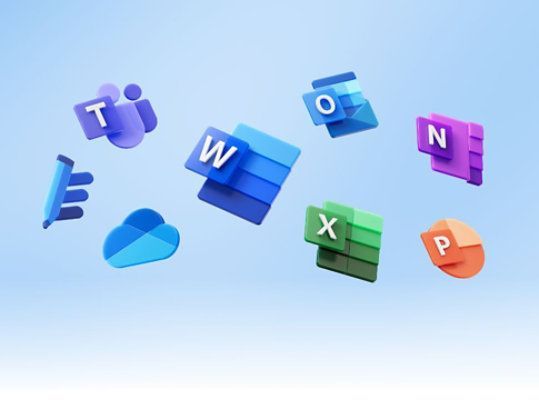
Imagine a classroom where students collaborate effortlessly, teachers manage their lessons with ease, and learning continues beyond the four walls of a school. This is the power of Microsoft 365 in education. With tools like Teams, OneNote, and SharePoint, schools can enhance communication, improve organization, and create an engaging learning experience. But how can schools implement Microsoft 365 without the usual hiccups? In this guide, we’ll break it down step by step to ensure a smooth transition for educators, students, and administrators.
Start with a Clear Implementation Plan
Before diving in, schools need a structured plan. This should include:
Goals & Objectives: Define what you want to achieve—better collaboration, seamless remote learning, or efficient document management?
Stakeholder Involvement: Involve teachers, IT staff, and administrators from the start to ensure all perspectives are considered.
Timeline & Milestones: Set realistic timelines for implementation to avoid overwhelming staff and students.
Budget Considerations: Consider licensing costs, hardware requirements, and training expenses.
Choose the Right Microsoft 365 Plan for Your Institution
Microsoft offers different plans tailored for education, including Microsoft 365 A1, A3, and A5. Here’s a quick comparison:
A1: Free, cloud-based, with basic Office apps and security features.
A3: Paid plan with full desktop Office apps, advanced security, and device management.
A5: Premium security, analytics, and compliance tools, ideal for large institutions.
Choosing the right plan ensures that your school gets the best value without overspending.
Train Educators and Staff for Maximum Adoption
A successful Microsoft 365 rollout depends on how well educators and staff can use the tools. Here’s how to make training effective:
Start with the Basics: Teach teachers and students how to use Teams for virtual classes, OneDrive for cloud storage, and OneNote for digital note-taking.
Use Interactive Training Sessions: Hands-on workshops and video tutorials make learning engaging.
Appoint Tech Champions: Identify tech-savvy teachers who can assist others in learning Microsoft 365 tools.
Ensure Smooth Integration with Existing Systems
Many schools already use platforms like Google Classroom, Moodle, or school-specific portals. To avoid disruptions:
Check Compatibility: Ensure Microsoft 365 integrates well with your school’s existing software.
Use Single Sign-On (SSO): This simplifies access and security by allowing users to log in with a single set of credentials.
Sync with School Data: Automatically import student and teacher details to streamline account creation.
Prioritize Security and Data Protection
Cybersecurity is crucial in education. Microsoft 365 offers built-in security features, but schools must also take proactive steps:
Enable Multi-Factor Authentication (MFA): Adds an extra layer of protection for accounts.
Set User Permissions: Limit access based on roles to prevent unauthorized data exposure.
Regular Backups: Use OneDrive and SharePoint backup options to avoid data loss.
Leverage Collaboration Features for Better Learning
Microsoft 365 enhances collaboration through:
Teams: Conduct virtual classes, share assignments, and facilitate discussions.
OneNote: Allow students to take and share digital notes in real-time.
SharePoint: Store and manage learning resources in a centralized location.
Monitor Usage and Gather Feedback
To ensure ongoing success:
Track Adoption Rates: Use Microsoft 365 admin tools to monitor user engagement.
Collect Feedback: Survey teachers and students about their experience.
Make Improvements: Address challenges by tweaking training and support resources.
Conclusion
Implementing Microsoft 365 in education doesn’t have to be overwhelming. With a structured plan, the right training, and a focus on security and collaboration, schools can create a seamless digital learning environment. Whether you’re just starting or looking to enhance your current setup, these steps will ensure a smooth transition to a smarter, more connected classroom.
0 notes
Text
Why Choose a NBN Phone System for Your Business?
If you are an Australian business that requires a reliable phone system, it is worth considering moving to NBN-ready phones. A hosted solution will work across multiple locations with a good quality internet connection, and it is affordable.
It will enhance your communication within the office and with customers, without requiring expensive hardware or long wires. Talk to a telecommunications provider like SpinTel today to find out more.
Easy to set up
A hosted NBN phone system uses an internet connection to connect all your handsets. It is easy to set up and costs less than a traditional business landline. Moreover, it offers the same functionality as a traditional PABX system. It can be used with a variety of handsets and mobile apps.
Unlike traditional landlines, NBN phone system are more reliable. They work on a high-speed data network and provide HD voice quality. They also have a range of advanced features such as auto-attendant and video conferencing. They can even integrate with digital business tools to increase productivity.
The best NBN phone service providers will offer a wide variety of plans to suit different businesses. Choose a provider that specializes in business connections and has a dedicated support team. They will be able to offer features that are ideal for business use, such as 4G backup. They will also help you select the right hardware and software to meet your needs.
Easy to manage
As more businesses rely on remote workers, a NBN ready phone system provides flexibility for staff to work anywhere in Australia. This is made possible because most modern handsets and on-site PBX systems are already nbn-ready or can easily be switched to nbn-compatible systems by adding an ATA.
NBN-ready phone systems are also designed to be easy to manage and maintain. They usually have a central online portal that allows admins to manage almost all aspects of the system. For example, they can assign specific greetings to incoming calls and redirect them to any department. They can even set up multiple ringing patterns to ensure that all incoming calls are answered.
NBN-ready telephone systems are the best for small business owners that want to leverage NBN’s high-speed internet capabilities to make their calls cheaper and better. Moreover, they can still keep their traditional landline phone numbers which are important for branding, building familiarity, and for use in emergency situations. The initial purchase and installation costs of a hosted solution are similar to those of a traditional PABX, but recurring costs are much lower. This is because SIP phone line rental and call rates are far cheaper – up to 60% less if you choose the right provider.
Easy to expand
When it comes to a hosted nbn phone system, the amount of handsets you can add to your business is limitless (as long as you have a good data connection for each one). This means that your company can grow with your needs and the system will be easy to maintain.
However, there are some legacy services that will not be compatible with the NBN. These include EFTPOS, back to base alarms, fax and extension corded phones. These services can be transferred to an NBN business line but will have reduced functionality.
With the NBN rollout, a professional PBX phone system is now more accessible than ever. The NBN offers great bandwidth, which used to be something only large businesses could access. The NBN also has minimal upfront and installation costs and is a cost-effective way to manage calls across multiple offices. This makes the NBN an excellent choice for small businesses looking to upgrade their phone systems.
Low cost
NBN phone systems are a smart choice for small businesses, especially with high speed data services becoming affordable for smaller companies. A hosted NBN system is a solution that can be easily customised to fit your business needs and will cost you a fraction of what traditional landline networks would charge you.
Nbn phones work over a fast internet connection such as the one offered by SpinTel, which will enhance connections within your business and with customers. Many NBN plans offer home phone services bundled in as an add-on to your broadband service.
An NBN PBX system hosted over your high-speed internet connection eliminates the need for expensive hardware, long wires or on-site servers. Instead, all data and programming is hosted 'in the cloud' so your IP enabled handsets or soft-phone apps can connect to it automatically. A quality NBN service provider like SpinTel will also provide an online portal that manages most aspects of the phone system for you.
#nbn phone system#phone system#small business phone system#business phone system#phone system for businesses
0 notes
Text
Hosted Business Phone System
A hosted business phone system is a great solution for businesses with changing communication needs. It eliminates costs associated with hardware, installation and PBX maintenance.
This type of unified communications platform is also known as UCaaS. It’s popular with telemarketing companies to speed up lead list penetration, tech firms to automate simple customer service requests and e-commerce shops for increased sales conversion.
Easy to Set Up
Hosted phone systems are a cloud-based alternative to traditional switchboard systems. While a traditional switchboard requires an investment in hardware and space to house it, hosted business phone system technology resides offsite at your service provider’s data centers. This allows you to add phone lines and extensions, as needed, without paying for expensive onsite hardware.
Your PBX system will also provide you with powerful mobile features that help employees stay connected while on the go. For example, many reputable providers offer voicemail-to-email transcription services, allowing agents to read messages from their desktop or mobile devices to decide how best to follow up. This is particularly useful for remote or hybrid teams, whose productivity often depends on the ability to work from anywhere. You can even set up a virtual auto attendant to route calls to the most relevant agent.
Reliability
Unlike traditional private branch exchange (PBX) systems, hosted phone solutions operate through cloud servers instead of on-site equipment. This provides greater reliability and improved continuity.
A hosted business phone system can also help businesses reduce cost by avoiding the need for expensive hardware and installation fees. This allows businesses to invest more money into other essential services, like marketing, sales, and customer service.
Additionally, hosted phone systems use Auto Attendants to screen incoming calls and route them to the right person. This is a great feature for businesses that want to increase customer satisfaction and improve efficiency. For example, customers calling for billing inquiries can be routed to the accounts department for faster resolution. The best unified communications tools provide call analytics to track these interactions.
Scalability
As a business grows or shrinks, you need to be able to adjust your communications services to match the ebb and flow of your company. When choosing a hosted phone system, choose one with scalability options that allow you to add or remove lines easily and quickly, without expensive hardware upgrades.
Hosted VoIP solutions are also easier to manage than old-school hardware-based systems. The best hosted PBX platforms come with advanced communication features that modern businesses need, like auto attendants, ACD (automated call distribution), and video conferencing. Look for providers that offer easy-to-use management portals and mobile apps that enable you to handle all of your business communication needs from any device. In addition, ensure that your chosen provider offers industry-standard security measures, such as two-factor authentication and data encryption.
Flexibility
Unlike traditional hardware systems, hosted phone solutions operate in the Cloud and allow information to be stored remotely. This eliminates the need for hardware and streamlines maintenance costs. UCaaS providers also typically offer a variety of integrations to help businesses optimize their workflow.
Admins can easily manage call routing and forwarding rules, giving teams the freedom to work from anywhere. They can divert calls to employees’ mobile phones, home phone numbers or even their voicemails. They can also enable features like texting and video conferencing to connect remote employees.
A PBX system’s flexibility can be particularly useful for globally dispersed companies. Its scalability allows business owners to add lines and extensions with minimal work or additional costs. And its reliability delivers peace of mind with ample redundancy.
Convenience
Unlike traditional systems, which require expensive wiring and hardware, hosted systems are set up online. No technicians need to come to your office to install the system. Depending on your provider, it can be as simple as downloading the software to your desktop or smartphone.
Businesses rely on hosted phone system to take care of their unified
communication needs. These systems integrate with business applications like CRM and helpdesk tools to automate tasks, provide centralized data management, and unlock workflow optimization benefits that landlines can’t match.
Hosted PBX solutions also include advanced features that improve team mobility and support remote working. For example, call forwarding enables calls to be routed to different numbers without disconnecting the caller. This helps increase first call resolution rates and makes it easier for teams to work remotely.
#hosted business phone system#hosted phone system#cloud phone system#hosted pbx phone system#cloud based phone system
1 note
·
View note
Text
HP server email alerts in Windows Server
One of the most important tools you have as a system administrator is the simple email alert. No matter what the problem is, it’s great to have a head start on fixing it before the phone starts ringing. In the case of HP servers you can get an email alert so you will have a head start on any problems that arise. It just needs to be set up first, which is not super simple if you haven’t done it before. Luckily for you I have this nice little tutorial to walk you through it.
Some Considerations Before We Start
The first thing I should mention is that there are little differences in the way certain generations of servers (and different versions of the software) handle this process. I have used the methods described below on Gen 6 through Gen 9 servers. For the most part they are pretty similar, but you may see something on your server that doesn’t look quite like what I have here. Keeping that in mind I have tried to point out any discrepancies I have seen and to give you as much information as I can so you can hopefully bridge any gaps you may come across.
Also, you may notice the names Hewlett-Packard, HP and HPE used interchangeably. In fact, HPE (Hewlett Packard Enterprise) is now a separate company from HP (Hewlett-Packard). They split around 2016 and now HP sells computers and printers and HPE handles servers. Doesn’t really matter to us except that HPE is starting to change things and that’s okay because otherwise life would be boring, right? Anyway, let’s get into it.
HPE’s servers use “Insight Management Agents” to monitor the health of their hardware. These are drivers that you need to install on the server. With the agents installed you can set up email alerts to tell you when something goes wrong with the server. On Gen 9 and older servers these are all free downloads. On servers newer than Gen 9 this functionality has been moved into the iLO and requires a paid license. I will cover that in a separate tutorial.
Installing Drivers
The first thing we are going to install is the “iLO Management Controller Driver Package”. The version you want will depend on the server’s iLO version. For example, the download for iLO 3 and 4 for Windows Server 2016 and 2019 which I will be using in the examples below is here: https://support.hpe.com/hpsc/swd/public/detail?swItemId=MTX_e20968c891b444c6b6de68a734
If you need a different one, you can probably find it here: https://support.hpe.com/hpesc/public/km/search#q=Management%20Controller%20Driver%20Package&t=All&sort=relevancy
Once the “iLO Management Controller Driver Package” downloads, right-click it and choose “Run as administrator”. You will see a setup wizard that looks like this:
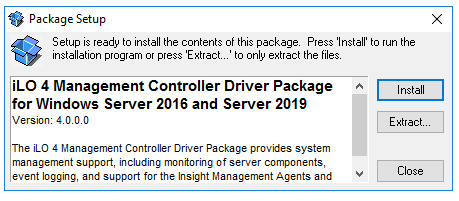
Click the “Install” button and let the installer run its course.
Next, download and install the “Channel Interface Driver” for your operating system. You should get at least version 3.31.0.0. If you don’t there is a very real chance of random crashes. I have seen it myself. There is a bug in the older versions of the driver (https://downloads.hpe.com/pub/softlib2/software1/sc-windows/p2015029342/v154233/cp036919.exe). The download for the Windows Server 2016 version is here: https://support.hpe.com/hpsc/swd/public/detail?swItemId=MTX-c5e0ed82c4864327bc9b86442c#tab-history. For other versions, just google “iLO 3/4 Channel Interface Driver Server 2008 R2” for example.

You may have to reboot afterwards in order to finish the installation. Hopefully you are doing all of this on a new server so you won’t be interrupting anything important. Otherwise use a scheduled task to reboot the server at a time when no one will notice.
Next we will install the HPE System Management Homepage which will allow you to check the status of your server in the web browser at https://localhost:2381.
Use this link to download it and run the executable as an administrator: https://support.hpe.com/hpsc/swd/public/detail?swItemId=MTX_b36fb879335a41d78ee5e99f7f
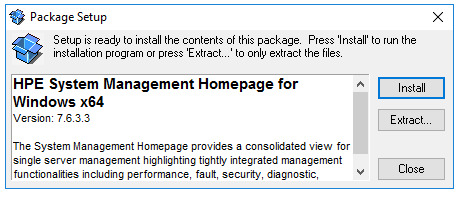
Installing the SNMP Service
In order for the HPE tools to communicate with each other (and us!) we need to install the SNMP service. Microsoft describes the SNMP services as follows: “The Simple Network Management Protocol (SNMP) is used to configure remote devices, monitor network performance, audit network usage, and detect network faults or inappropriate access.” Exactly what we want, right?
To install the SNMP service, go to Server Manager, then click “Manage”, then “Add Roles and Features”. Choose “Role-based”, Next, select the local server, Next, Next, on the “Select Features” screen check the box next to “SNMP Service” and the one inside it, “SNMP WMI Provider”. You may be prompted to install “SNMP Tools”, too, if you don’t have it installed already. Get it, you’ll need it.
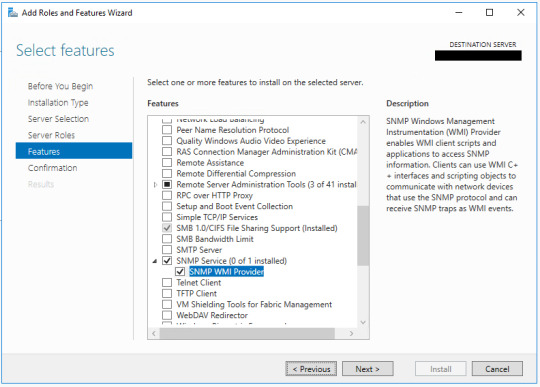
Click Next, then click Install.
Once the installation of SNMP service is finished, click the Start menu and type services.msc (or Windows key and R key on the keyboard and enter services.msc) to open the Services interface.
Find the SNMP Service and make sure it’s running.
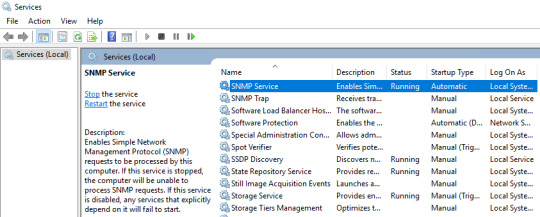
Installing the Agents
Next, we will download and install the HP Insight Management Agents. Here is the link for the newest version at the time of this writing: https://support.hpe.com/hpsc/swd/public/detail?swItemId=MTX_1b0b099098874404adcb5d1d51#tab1
Run the executable as and admin and click Install.
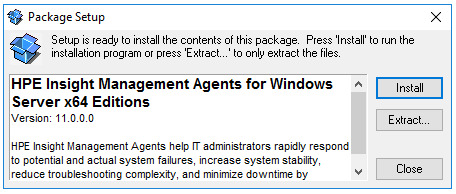
When the install completes, the “Management Agents” window will open.
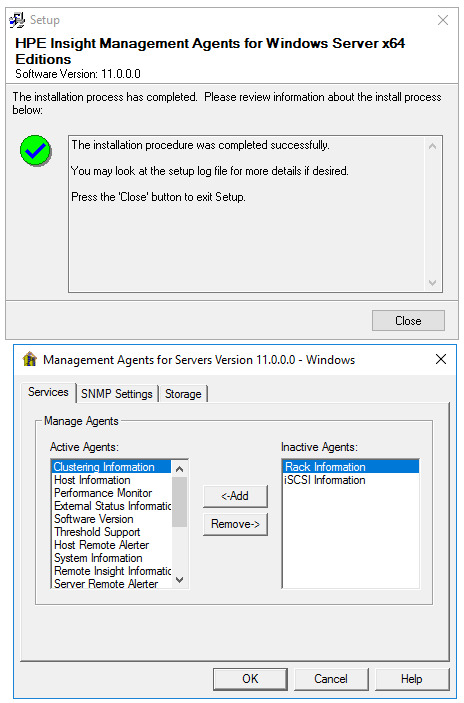
When the install is finished the “HPE Management Agents” settings will open automatically. You may notice there is a button on the “SNMP Settings” tab that says: “Send Test Trap”. We will come back to this later. It won’t work until we take care a few other things so you can click cancel for now.
Configuring SNMP
Now that we have the HPE agents installed we need to configure the SNMP service to collect information from the agents. Open Services.msc by searching in the Start menu or Windows key + R and entering Services.msc. Scroll down to “SNMP Services” and double-click on it. In the security tab, click Add button under “Accepted community names”. There are two Add buttons on this tab so click the top one. Select Community rights as “READ ONLY”. Type “Public” for the Community Name and click Add.
If you don’t have the Security tab close Services.msc and restart it.
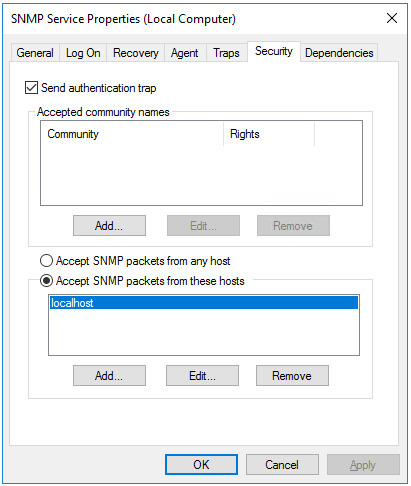
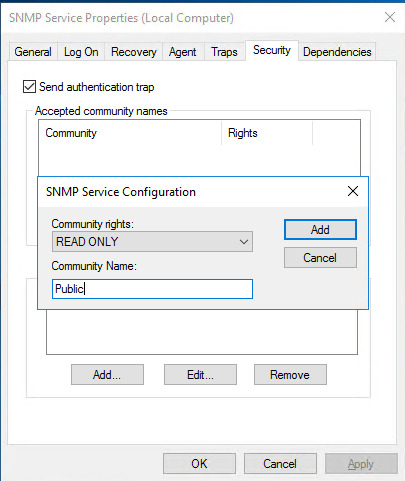
Click the same Add button again and create another Community Name called “Private”, but this time make the Rights “READ WRITE”.
Now we will tell the SNMP service who to accept packets from. With the “Accept SNMP packets from these hosts” radio button selected, click on the lower Add button now and enter 127.0.0.1 as the IP address. This is the localhost so the SNMP service will only be listening to this server we are working on. Click Add and then Apply.

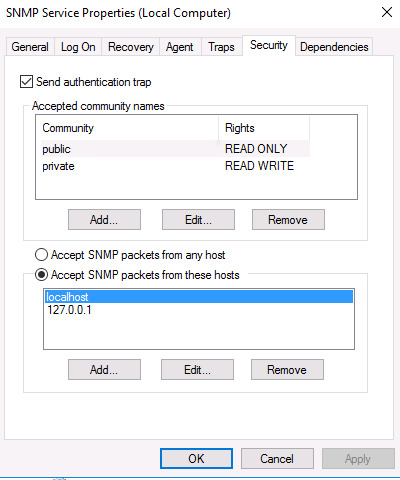
With this done, go to the Traps tab in SNMP Service properties. You will have to type directly into the drop-down list because it doesn’t populate itself. Type “public” and now the “Add to list” button will be clickable. Click it. The drop-down list now has an entry for “public”. Click the “Add” button lower down the Traps tab and enter 127.0.0.1 and then click the Add button.

Click Apply and Ok.
Your New Services
You may notice that you have several new services in your Services.msc window. Their names differ depending on the version you install, but they will be similar to:
HP Insight Event Notifier
HP Insight Foundation Agents
HP Insight NIC Agents
HP Insight Server Agents
HP Insight Storage Agents
HP Smart Array SAS/SATA Event Notification Service
HP System Management Homepage
HP WMI Storage Providers
The names pretty much tell you what they do, but you can click on them in Services.msc to get a more detailed description.

They should all be started except for the HP Insight Event Notifier service. It needs to be configured before it will start. Let’s do that now. In the Start menu go to “HP Management Agents” and run the “Event Notifier Config” as administrator. The instructions are right there in the wizard for you.
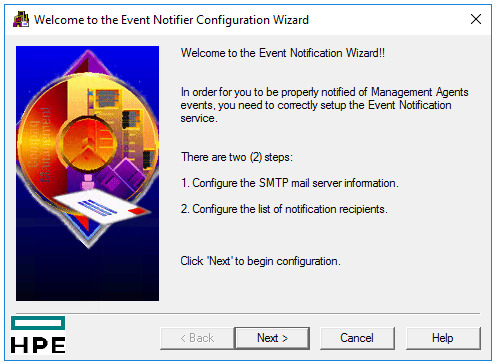
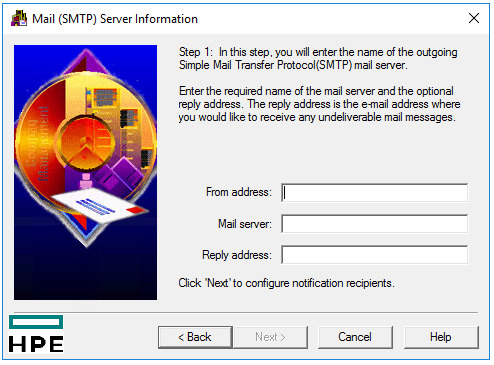

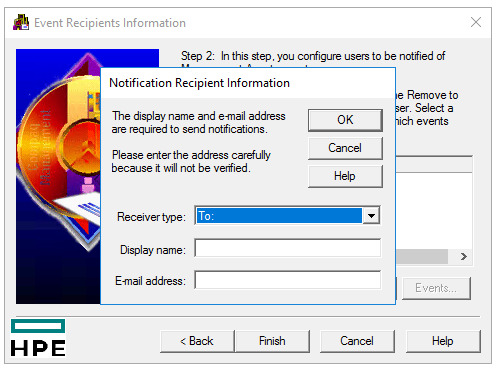
You can also click on the Events button to choose which events trigger the notications. You can have different events selected for different recipients. All of them are selected by default. When you have all of your recipients in there, click finish.
Keep in mind any time you want to change these settings you must open “Event Notifier Config” as an administrator by right-clicking. Otherwise the settings will all be blank like it was never set up in the first place.
Back in the Services.msc window right-click on “HP Insight Event Notifier” and then click Restart. You can also double-click on it and then click the Start button.

If the “HP Insight Event Notifier” service doesn’t start, check your event viewer and you may see an error that will help you. For example, if you try to start that service without first running through the “Event Notifier Config” you will see two errors:
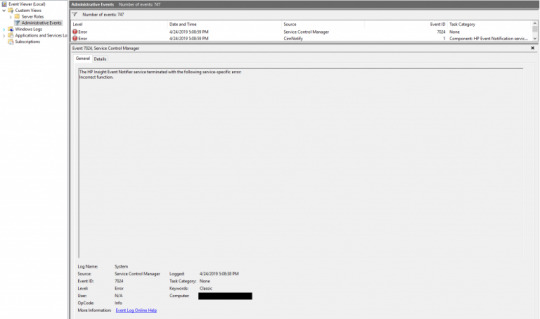
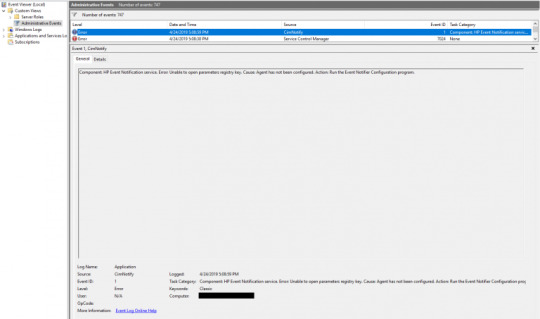


If that’s the case, set up the “Event Notifier Config” and it should work.
Back in the Services.msc window find the “HP System Management Homepage” service. Right-click it and click “Restart”.
The HP System Management Homepage
Now let’s open the HP System Management Homepage. There is probably a shortcut on your desktop, but if not, you will find it in the Start menu under “HPE Management Agents”. You can also type https://localhost:2381 into your browser. Log in to the homepage with an administrator account. If you are using a domain admin account enter it in the format of DOMAIN\username. If you’ve set everything up correctly you should see something like this:

To see some diagnostics, you can go to Logs > Integrated Management Log:
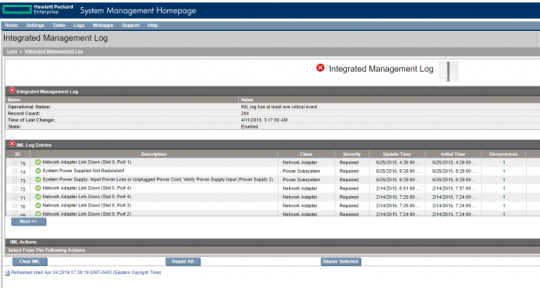
Explore this to see all of the nice stuff it tells you about your server. However, you can’t always be in here staring at it and waiting for problems to pop up, so we need to get the alert emails coming in. There are a couple of ways to send a test email. One is right here in the System Management Homepage.
The next part is different depending on the version of these programs you have.
To send a test email alert with the System Management Homepage, first click on Settings, then SNMP & Agent Settings.
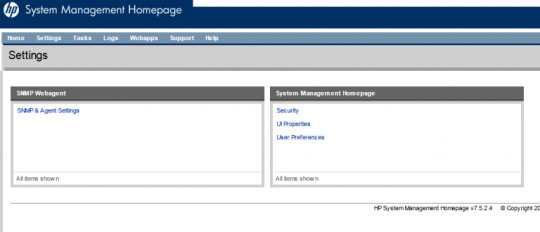
In here you will find another view of the SNMP settings we saw in Services.msc. On the left side of the page you should find the “Send Test Trap” button. Click that and then click Ok when it asks you if you are sure. This next screenshot is from version 7.5.2.4 of the System Management Homepage. Other versions look a lot different and don’t give you as much control. Also, they are moving this functionality into the iLO starting with Gen 10 servers. More on that in another article.
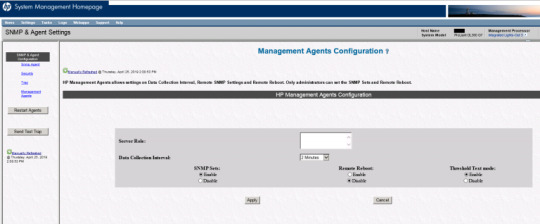
Some versions of the Homepage have a different area where you can send a test indication, but it doesn’t send an email. It just sends a message to the event viewer. To try that out you can go to Settings, Test Indication, Send Test Indication. This is from version 6.2.0.13:


Here is an example of the “Test Indication” error that was sent to the event viewer:

Sending a Test Alert
The most reliable place to send a test email from is the Control Panel app they’ve given us as part of the HP Management Agent installation. This app seems to be present in all versions of these programs.
Open the Windows Control Panel and find “HP Management Agents”. Click on “View By” and choose “Large Icons” to find it easier. Right-click on it and run it as administrator.
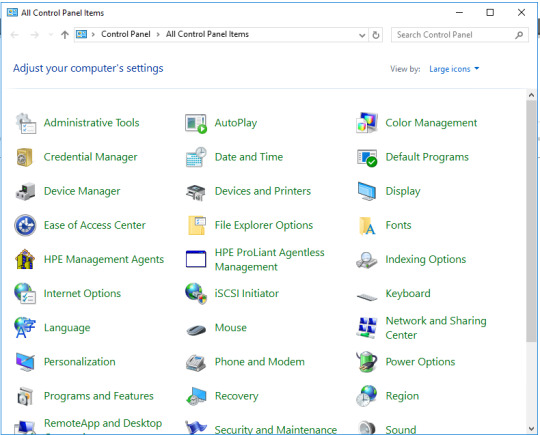

In the first tab that opens you will see all of the types of agents that are working in the background. The important ones should already be set up for you. To send a test email alert click on the “SNMP Settings” tab.

You don’t need to change anything here either. Just click the “Send Test Trap” button. If the “Send Test Trap” button is greyed out, check to make sure the “HP Insight Foundation Agents” service is running in Services.msc and you are running “HP Management Agents” as administrator. If you see the following error after clicking “Send Test Trap”: “The Management Agents Remote Alerter agent has not finished initializing or is not enabled. The test trap was not sent.” then you are probably not running “HP Management Agents” as administrator.

If you’ve set everything up correctly you should get a message box like this: “The following trap has been sent” with the date and time.
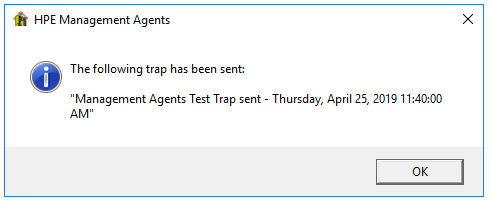
And you should receive and email that says “The system has detected the following event:” with the date, time, server name, and the description of the error:

If you get that email, then congratulations! You’re all set to receive an email alert when something goes wrong.
If you don’t get an email you may have to add the server to your Exchange receive connectors or make some other change depending on how you are set up. Also, check the services in Services.msc to make sure they didn’t stop running for some reason.
Here is an example of a dead battery error:

You might want to try sending a test email once a month or so to make sure it’s all still working. Have fun!
1 note
·
View note
Text
Operations Manager, at Democracy at Work Institute
Democracy at Work Institute (DAWI) seeks an energetic, experienced, self-directed and collaborative person to join our dynamic national organization supporting the expansion of democratic employee ownership.
About the Job
The Operations Manager will work closely with the Executive Director, program staff, operations staff, board members and volunteers, to ensure that everyone in our mostly-remote organization has the tools and supports necessary to do their work well. They will set up, monitor and maintain systems for the Oakland, New York City, and remote offices, ensuring that the Institute’s infrastructure supports effective programs and fundraising and a happy, productive team.
We are looking for an operations wizard. This position requires an unusual set of skills -- technological, systems, and human -- and we are seeking someone who really enjoys operations/administrative work and wants to do it for the foreseeable future. If you have a larger picture of how organizations work and what they need, perhaps from working in other nonprofit program or leadership roles, that’s a plus. We are a high-functioning, close-knit staff with a healthy respect for the operations work, and we want to work with a skilled and reliable colleague. This position has potential to grow as the organization grows.
Operations and Systems Administration (45%)
Manage email and phone inquiries; route to appropriate staffer for follow-up
Provide IT support for main and remote offices, making sure technological systems are appropriate and functioning to support our team to do their jobs.
Maintain and support IT hardware and software across the organization
Support IT troubleshooting and accessing outside support
Maintain organized electronic (Box, Google docs) and physical files
Support and work with Finance Manager
Maintain office and program supplies
Maintain staff travel calendar; assist staff in planning travel. Ensure that standard preparation, debrief and reporting happen for all staff travel events
Provide operations and logistics support for event planning, including bi-annual national conference
Executive Administration (20%)
Manage the Executive Director’s calendar. Support scheduling, meetings, and travel
Support the administrative and logistical needs of the Board of Directors, mostly meeting scheduling and preparation; some onboarding and offboarding tasks (i.e. coordinate retreats and Executive Director evaluation, Executive Committee support)
Work with the ED to assess the organization’s systems needs. Continually synthesize fragmented para-systems. Research, propose and lead new systems implementation
Database Support (20%)
Manage and perform routine data entry and data cleaning
Support the collection of metrics and evaluations for annual reporting
Assist Metrics and Impact Analyst with database design and development Human Resources Administration (10%)
Coordinate the hiring committee’s recruitment, interviewing and onboarding for new hires
Coordinate and support employee offboarding processes
Maintain employee evaluation calendar and records
Coordinate annual benefits enrollment
Collaborate with Member Personnel Committee on policy development and implementation
Bottom line all HR records/file management, including all contractor and employee files
Oversee the 360 evaluation process for staff and the executive director.
Contracts and Grants Administration (5%)
Manage fundraising and reporting calendar and deadlines; provide prompts and support
Support Contracts Manager to maintain and organize contracts with clients and vendors, manage client pipeline and prospecting.
Skills and Qualities We Seek
We are seeking someone with strong tech skills, excellent proactive communication habits, and experience developing and supporting systems with real people in mind.
Required:
Basic operations experience: at least 4 years of experience in an admin or operations role.
Full competency with basic office tools: Microsoft Office Suite, GSuite, online project management systems, remote file systems, online/remote meeting tools.
Facility with new technology: you can learn and teach programs to take the organization to the next level of cybersecurity and functionality, and you are willing to approach tech troubleshooting without fear or frustration.
Database, data entry and data management experience (CiviCRM is a plus but we can teach you if you know databases generally).
Strong organizational skills, task-tracking and 100% follow-through on deadlines: you are able to set priorities, manage time well, establish realistic deadlines and meet them consistently.
Strong written and oral communication skills across all mediums.
Initiative and ability to anticipate organizational needs: you can identify gaps, improve systems, and implement effective operations models.
Remote work: you like to work independently and can prioritize and execute day to day tasks, with self-management systems in place.
Desired
Basic budgeting and bookkeeping skills; familiarity with Quickbooks.
HR and benefits administration experience.
Passion for social justice, racial equity, small business, and/or labor organizing; willingness to build familiarity with employee ownership and worker cooperatives
We value emotional intelligence, kindness, and sense of humor. Diplomacy, judgment, and discretion are important in this position.
About DAWI
The Institute is a 501(c)(3) nonprofit movement-based think-and-do tank that expands the promise of cooperative business ownership to communities most directly affected by economic, social, and racial inequality. We do research and advocacy; we develop tools and new models; we train worker-owners and developers; and we build cooperative development capacity to ensure that further growth in the worker cooperative movement reaches low-income people, people of color and recent immigrants. In all our work, as well as internal operations, we strive to embody our organizational values of Excellence, Equity, Entrepreneurialism, Collaboration, and Human-Centeredness. We are affiliated with the US Federation of Worker Cooperatives, the national grassroots membership organization. All programs integrate USFWC member input and foreground the experience of worker cooperatives.
Started in 2013, DAWI is a relatively young organization, and all staffers are expected to help build organizational capacity, including organizational processes and documents. We love our work, and we work hard, but we also strive for work-life balance. We are a small team with extremely low staff turnover.
Full-time staff are eligible for membership in the organization after 6 months of employment. Members are eligible to serve on the board of directors, elect two directors, and participate in the strategic guidance of the organization.
We are a remote organization with offices in Oakland and New York. This allows us to have staff all over the country, and to create flexible working hours and locations. It can also be challenging for developing systems, getting buy-in for their use, and maintaining consistency of practice —a key part of this job. All staff are expected to be able and willing to learn and help improve the technological tools for remote working. A certain amount of travel for all staffers is expected and supported. For this position, we prefer someone who can work out of our Oakland office, but we will consider strong candidates from all locations. We are open to contractors.
Notice of Nondiscrimination
Democracy at Work Institute (DAWI) is committed to a multi-racial and class-diverse staff that reflects the future of worker cooperatives. Women, people of color and others who may be underrepresented at senior levels of the nonprofit workforce are strongly encouraged to apply. DAWI is committed to equal opportunity for all persons without regard to sex, age, race, color, religion, creed, national origin, marital status, disability, or sexual orientation, and any other class of individuals protected from discrimination under state or federal law. It is the policy of DAWI to comply with all federal, state, and local laws and regulations regarding equal opportunity. In keeping with that policy, DAWI is committed to maintaining a work environment that is free of unlawful discrimination and harassment. Accordingly, DAWI will not tolerate unlawful discrimination against or harassment of any of our employees or others present at our facilities by anyone, including any supervisor, coworker, vendor, client, or customer of DAWI.
Compensation and Benefits
$50,000-$65,000 depending on experience. DAWI offers full health benefits coverage for employees, including dental and vision; participation in a 401(k) plan; a generous time-off policy; and a professional development budget.
To Apply: Email a cover letter, resume, and two references to [email protected]. Cover letters should be addressed to the Hiring Committee and include a 2-3 paragraph statement of interest describing how your skills and experiences qualify you for the position. Include the subject line “Application for Operations Manager position.” All materials should be submitted in PDF format. Deadline to apply: October 25, 2019.
1 note
·
View note
Text
Track, Analyze, Optimize: Time and Attendance Software with Live Data Insights
Time and attendance software has evolved into a strategic tool—delivering real-time insights, boosting productivity, and ensuring compliance across dispersed teams. It’s no longer about just recording clock-in and clock-out times. The new generation of workforce management platforms offers live data insights that empower HR and leadership to make informed, timely decisions.
With hybrid work models, flexible hours, and globally distributed teams becoming the norm, businesses must embrace time and attendance software that is not only cloud-connected but also robust enough to adapt to evolving needs. The best part? It can all be managed from a centralized dashboard.

Why Live Data Insights Matter
Real-time data insights are the lifeline of modern time tracking systems. Gone are the days of manually updating spreadsheets and chasing paper-based timesheets. With intelligent time and attendance software, HR departments can view live attendance reports, late arrivals, early departures, overtime trends, and absence patterns—across locations and departments.
This enables companies to:
Make data-driven decisions regarding staffing, project allocation, and shift planning.
Ensure compliance with labor laws and reduce the risk of errors in payroll processing.
Identify productivity bottlenecks and address absenteeism patterns.
Gain transparency, which promotes employee accountability and organizational trust.
The ability to access these insights instantly is a game-changer, especially for businesses operating in industries where labor management and timing are critical—such as manufacturing, logistics, healthcare, and hospitality.
Benefits of Modern Time and Attendance Software
Smart, cloud-based time and attendance software offers a suite of features that benefit both employers and employees. These include:
Cloud Connectivity With a cloud infrastructure, data is stored and accessed in real-time from anywhere. This is vital for businesses with remote and hybrid workforces. Managers can monitor staff attendance even when working from a different city or country.
Mobile Access and GPS Tracking Employees can check in and out using their smartphones, while GPS tagging ensures that the attendance is location-authenticated. This proves especially useful for field teams and businesses operating across multiple worksites.
Seamless Integration Modern solutions integrate effortlessly with payroll, HRMS, and project management tools. This reduces redundant tasks and ensures consistency across platforms, saving time and reducing administrative workload.
Biometric Compatibility Time and attendance software today often pairs with biometric attendance devices to eliminate time fraud, buddy punching, and unauthorized access. The synergy between software and biometric hardware enhances both security and accuracy.
Customizable Dashboards and Reports Each organization has unique metrics it wants to track. The right software provides customizable dashboards and reports so decision-makers can focus on what matters most to them.
Policy Automation Managing overtime, leave policies, and shift rotations becomes simpler with automated rules embedded within the software. HR teams can configure workflows based on organization policies.
Choosing the Right Time and Attendance Solution
With numerous platforms on the market, choosing the right time and attendance software boils down to a few crucial factors:
Scalability – Can it grow with your organization?
User Experience – Is it intuitive for both admins and employees?
Data Security – Does it meet your data privacy standards?
Hardware Compatibility – Does it support biometric or RFID devices if needed?
Support and Updates – Does the provider offer regular feature enhancements and technical support?
Some solutions stand out because of their flexibility, integration capabilities, and cloud-first architecture. One such platform is Spintly, which offers a seamless blend of hardware and software for organizations looking to modernize their attendance tracking and access control systems.
Without directly naming names, it's worth noting that companies exploring modern solutions often find value in platforms that provide smartphone-based attendance, Bluetooth and biometric integrations, and real-time analytics—all under a unified dashboard.
The Power of Real-Time Optimization
With live insights, companies can go beyond just recording attendance—they can optimize their workforce strategy. Consider a scenario where absenteeism increases in a particular department. Live data alerts management immediately, allowing them to redistribute tasks or hire temp staff before the situation impacts project timelines.
Similarly, analyzing attendance patterns across different locations might highlight disparities in team productivity. This can prompt HR to investigate deeper, uncover challenges, and implement corrective measures—all in a proactive rather than reactive manner.
Real-time analytics also allow for dynamic shift planning. If one shift consistently logs higher overtime, it might be a sign of understaffing. Adjusting shift allocations using these insights can lead to more balanced workloads and improved morale.
Remote Teams and Attendance Accountability
The rise of hybrid and remote workforces has made traditional attendance methods obsolete. Managers now require systems that allow remote attendance marking, geolocation tagging, and attendance verification—all of which are built into modern platforms.
Live data also promotes trust in remote work models. Employees know their efforts are being fairly tracked, while management retains visibility without micromanagement. This balance fosters a healthier work culture.
Looking Ahead: The Future of Attendance Management
Artificial intelligence and machine learning are already making their way into time and attendance systems. Predictive analytics will soon help managers anticipate absenteeism trends, forecast workforce needs, and even automate resource planning.
IoT devices and wearable tech could further revolutionize how we think of attendance and productivity monitoring. As all this unfolds, the importance of choosing a flexible, cloud-ready platform cannot be overstated.
Businesses that are serious about workforce optimization should look toward smart, scalable, and mobile-friendly time and attendance solutions. Those that offer biometric integrations, real-time analytics, and seamless user experiences are leading the charge.
Conclusion
Tracking employee attendance has come a long way from punch cards and Excel sheets. Today’s organizations need software that does more than record hours - they need systems that provide actionable insights, support real-time decision-making, and adapt to an increasingly mobile workforce.
If you're in the market for a solution that merges innovation with ease-of-use, exploring platforms like Spintly could set you on the right path. With the right time and attendance software, your organization can go from tracking time to maximizing it.
#attendance management#time and attendance software#attendance#biometric attendance#attendance system#mobile access#accesscontrol#visitor management system#spintly#smartacess#access control solutions#access control system#smartbuilding#biometrics
0 notes